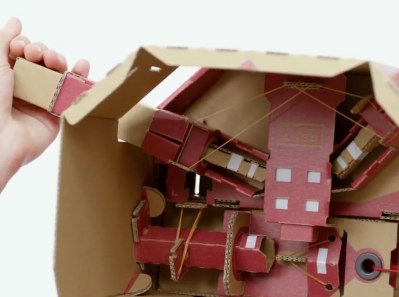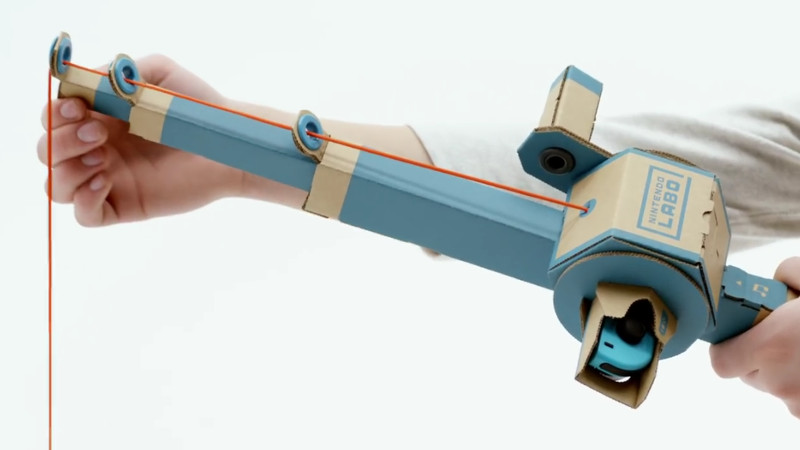Over the years, Nintendo has had little trouble printing money with their various gaming systems. While they’ve had the odd misstep here and there since the original Nintendo Entertainment System was released in 1983, overall business has been good. But even for the company that essentially brought home video games to the mainstream, this last year has been pretty huge. The release of the Nintendo Switch has rocketed the Japanese gaming giant back into the limelight in a way they haven’t enjoyed in a number of years, and now they’re looking to keep that momentum going into 2018 with a killer new gaming accessory: a cardboard box.

Well, it doesn’t have to be a box, necessarily. But no matter which way you fold it, it’s definitely a piece of cardboard. Maybe a few bits of string here and there. This is the world of “Nintendo Labo”, a recently announced program which promises to let Switch owners create physical objects which they can interact with via specially designed software for the console.
The Labo creations demonstrated in the bombastic announcement video make clever use of the very unique Switch hardware. The removable Joy-Con controllers are generally still used as input devices, albeit in less traditional ways. Twisting and tilting the cardboard creations, which take varied forms such as a fishing rod or motorcycle handlebars, relays input to the appropriate game thanks to the accelerometers and gyroscopes they contain.
Many of the more complex contraptions rely on a less-known feature of the controller: the IR depth camera. By pointing the controller’s camera inside of the devices, the motion of internal components, likely helped along by IR-reflective tape, can be tracked in three dimensions. In the video, the internal construction of some of the devices looks downright intimidating.
Which leads into the natural question: “Who exactly is this for?”
Clearly some of the gadgets, not to mention the folded cardboard construction, are aimed at children, an age group Nintendo has never been ashamed to appeal to. But some of the more advanced devices and overall concept seems like it would play better with creative teens and adults looking to push the Switch in new directions.
Will users be empowered to create their own hardware, and by extension, associated software? Will hackers and makers be able to 3D print new input devices for the Switch using this platform? This is definitely something we’ll be keeping a close eye on as it gets closer to release in April.
The popularity of the Switch has already given rise to a surprising amount of hacking given how new the console is. It will be interesting to see if the introduction of Labo has any effect on the impressive work already being done to bend the console to the owner’s will.
















If you’re a fan of RiffTrax, you’ll have heard of their treatment of ACI’s “Boxes At Your Fingertips,” which instantly makes you happy that they did this:
https://www.youtube.com/watch?v=kfhfz7UeAq8
Thanks for this, some faith in humanity restored. Love MST3K
Wow, that was so bad…
One of the main goals for Labo is to teach and inspire children about the various STEM fields. The idea being that, as they put these things together and then see how they work, kids will learn about the fundamentals behind it all, and then look into doing something similar on their own… with a Raspberry Pi or an Arduino kit. A new generation of hackers!
Maybe, if Nintendo make the Labo platform open to user development. However Nintendo haven’t historically been friends to people trying to do things with their hardware for free.
To be fair, they created Mario Maker. The issue is not letting the system run unsigned code, but creativity is certainly in their vocabulary. It’s just the levels of access that you want vs what they want to give are on vastly different tiers. For kids, this IS a good start. I found it telling that in the video, some of the x-ray views shown not only show cutaways of the cardboard structures, but the internals of the joy con as well. That’s pretty cool on Nintendo’s part, and certainly an eye catcher for a young impressionable kid who might suddenly find a newfound fascination with how things work, thanks to Labo.
I’m not so sure your correct in the assertion they aren’t friends to people trying to do things with their hardware for free. Look at the NES controller for a good example of this. Stupidly simple design, it didn’t have to be this simple and in the interest of maintaining hold over the platform would have been in their best interest to make it much more complex. Instead they used a fairly well documented shift register. Then again with the Wii Remote. They could have did the Microsoft thing and invented their own Bluetooth spec for the thing. Instead they used very vanilla USB-HID over Bluetooth protocol, you don’t even need a successful handshake to connect to it, just the attempt to do so is good enough for the official Nintendo Wii Remotes.
While these seem like cost cutting measures, it really looks more like leaving it open to those with the experience or will to learn. I learned USB-HID over Bluetooth specifically for the Wii Remote and it was a relatively painless process.
I agree with you on this, Nintendo has always been a toy maker first technology company second. They absolutely love making bits of plastic to go with all of their systems.
Focusing on toys and not necessarily tech allows them to use hardware appropriately, they understand that hardware exists to serve software. That being said, Nintendo typically uses older well specc’d technologies near the end of their life cycle. One because it’s cost efficient, and two because they focus more on the experience of the user; as long as you buy their toy they don’t care. I don’t necessarily think the toy is the console, but instead all the peripherals that go with it. Controllers and games included. Consoles them selves are usually made and sold at a loss with expectation that you buy more controllers, plastic bits, and games later on.
Granted their development tool suite for the WiiU was hot garbage at launch, it was this nasty visual studio thing that plugged into another IDE for embedded stuff. However, they eventually cleaned it up a bit.
I need this for all my deep, dark, gachimuchi fantasies.
Cardboard Origami
I think what most are missing is that you can experiment too,
Nintendo is know for releasing slews of controllers and attachments,
some that don’t sell well,
This allows them to research the market hard,
This is a new age of knowing what customers want,
If nothing else, cardboard is easier to dispose of than all the plastic guitars filling closet junk boxes and eventual landfills.
Jesus, I can’t get away from this stupid cardboard thing. I really don’t see how this could be much better than some crappy gimmick, with the sole caveat that it could be really interesting if Nintendo included some sort of “Game Maker”-esque SDK to go with it. That way, it WOULD actually have some staying power, what with seeing what you and others could come up with.
But they won’t, because it’s Nintendo.
Except, I could see them actually trying to do something like that. Have you not heard of Mario Maker? It would be great if they would develop a creativity suite, that allows you to place a variety of objects and planes together, and have it generate cut-out instructions for an object, and allow you to assign specific objects within the structure to perform tasks in an activity suite. Something like Little Big Planet comes to mind, but with an element of physicality built into it.
Yes, except Mario Maker is little other than a glorified level editor. I don’t think you’re going to get anything good out of this by copypasting tiles into a level layout.
To make the whole Labo idea ACTUALLY worthwhile, you’d need some sort of development suite much more powerful than that, to the point that it would essentially kill any future money-making attempts off of the same system. Why would you buy the official crap when you would have the Nintendo equivalent of the Steam Workshop available?
I don’t know, it’s not impossible, but, with current-era Nintendo’s paranoid, walled-garden attitude, I’d be extremely surprised if we get anything more than metaphorical cardboard Amiibos at $9.99 each.
Fun fact about celery: It only contains 10 calories in the ground and instantly fills out to a healthy 200 calories as soon as it is cut.
Fun fact number 2: Celery is great for number 2s with all of its fiber content.
FUZE Basic is slated to come out for the Switch in the next few months. If they’ve not already got functions making use of the IR camera already set up, then surely they’re working it in right now.
Also, it’s already at least somewhat open – the LABO introduction vid shows a scratch/PD style visual interface for making your own stuff. That’s what the otherwise feeble-looking ‘cardboard man that falls over’ was demonstrating.
Cool stuff! I haven’t been this excited for a nintendo thing since Splatoon :)
And I said I wasn’t interested because of the price tag. Then they announced you can just get the game and build the stuff on your own with their free templates. I’m interested again. That would make a challenging project.
Happy meal technology.